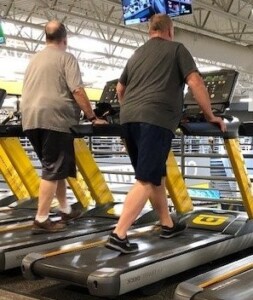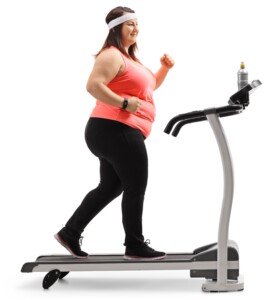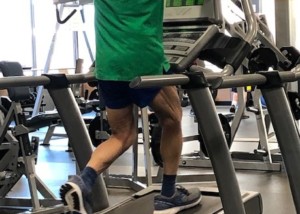
Here are instructions on how to lose 100 pounds using a treadmill without running.
One reason you have not lost weight despite spending a lot of time on a treadmill is because you’ve been holding onto the device.
This is a very common way that people of all sizes use a treadmill, but it’s almost universal among obese users.
And it begets MINIMAL results. Minimal. Do you know what “minimal” means when you’re trying to lose 100 pounds? You cannot afford minimal!
Now, if you walk without holding onto the treadmill, but continue to eat far more calories than your body can burn off…you will not lose the weight you want to get rid of.
However, if you’ve been faithfully sticking to portion control and to treadmill workouts…without seeing much of a change in your body, I’ll bet the entire farm that you’ve been holding onto the machine this whole time.

So very wrong.
Losing 100 Pounds with a Treadmill Requires More than Letting Go
In addition to swinging your arms, you must also employ a technique called high intensity interval training if you want to drop a hundred pounds.
You can do this by walking.
Jogging is not necessary.
But you must embrace keeping your hands off of the machine (unless you want to temporarily steady yourself while sipping water).
Treadmill Formula for Shedding 100 Pounds
Always swing your arms. The next rule is to employ high intensity interval training (HIIT).
The basic formula is to set the machine so that 30 seconds of walking is exceptionally difficult.

Shutterstock/ Ljupco Smokovski
At the end of 30 seconds, you change the settings to an easy pace, and walk this for two minutes. So it’s 30 seconds on, two minutes off.
Yes, you will repeatedly have to change the settings. Though treadmills come with “programs,” none fit the template that I’m describing here, even the ones that are called “interval” or “fat burn.”
The template is 30 seconds on, two minutes off. But the “off” is very easy.
If you feel fully recovered after only one minute, than your 30-second work interval wasn’t intense enough. How do you know it IS intense enough?
At the end of it, you’re nearly completely out of breath. You can’t talk. You need the full two minutes to recover and repeat the work interval.
The setting for the work interval will vary from person to person. A 25-year-old who wants to lose 100 pounds is, in general, fitter than a 50-year-old with the same goal.
On the other hand, that 50-year-old maybe does a lot of walking outside, even some hiking.
And maybe the 25-year-old doesn’t do any form of exercise and sits at a computer 10 hours a day. There are all sorts of variables.
So thus, there is no specific setting for the work interval. It’s whatever you cannot do longer than 30 seconds. And remember, there is NO holding on.
If you’ve been holding on for a long time, you’ll find that letting go makes you discover muscles you never thought you had.
You’ll need to get used to this before truly going all-out effort with the work intervals.
Example of a HIIT Session on a Treadmill
Warm up for 10 minutes with 30-second intervals of escalating effort and sub-two-minute recoveries.
After 10 minutes or so, you’re ready to begin the first hard work interval. It might be 4 mph at zero incline. It might be 0.8 mph at 15 percent incline.
Remember, you must NOT hold on. So if you’ve previously (while holding on) have been doing 15 percent incline at 2.5 mph, you will have to significantly slow the speed to be able to walk without holding on.
Remember the rule: The setting must enable you to walk, but be too difficult to exceed about 30 seconds.
After which, you reduce the settings so that you can catch your breath and recover for two minutes.
If you’re using a high incline, the reduction will require a zero incline or close to it.
If you’re already at zero or close to zero grade during your work interval, you’ll need to slow the speed quite a bit.
So if 4 mph at zero, one or two percent incline has you panting very heavily after 30 seconds, unable to talk, then slow the speed to 1.5 mph, maybe even one mph, for two minutes.
Then reset the machine to whatever the work interval was (e.g., 4 mph at one percent incline).
If it was 0.8 mph at 15 or 14 percent incline…then your recovery interval might be 1.5 mph at zero grade.
The point is to simply get the setting down to what comprises an easy, casual pace to recover with.
If you find you feel you can walk longer than 30 seconds at your work interval, guess what:
You must INCREASE the speed and/or incline. If you’re already at 15 percent, jump the speed up a bit and see how you do.
If after 12 seconds you must hold onto the treadmill…then you bumped up the speed too much.
If you’re using a zero or low incline, and feel after 30 seconds you can actually continue at that speed…but you can’t mechanically walk faster (due to your size or a knee condition), then increase the incline.
Yes, HIIT requires some experimenting with…at first. But once you become acquainted with it, you’ll know precisely what setting ranges get the job done.
Do eight cycles: eight work intervals and eight easy-pacing periods. Then warm down for 10 minutes with de-escalating work intervals.
When this treadmill plan is coupled with sensible eating habits (plant based diet with portion control), and done three times a week, you will lose 100 pounds. It will take a while.
After all, we’re talking a hundred pounds, not 20. To expedite progress, you must incorporate intense strength training.


Shutterstock/Reshetnikov_art

Shutterstock/Aleksey Boyko

























